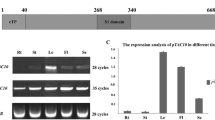Abstract
Visualizing full-length primary transcripts is helpful in identifying transcription initiation sites and mapping promoter regions of plastid genes and operons. Detection of primary unprocessed transcripts from certain regions of the plastid genome is difficult, and sometimes impossible, because of their rapid and extensive processing. We tested the effect of lincomycin, a prokaryotic protein synthesis inhibiter, on in vivo RNA processing activities in different types of rice plastid. Steady-state levels of RNA produced from the region of the rice plastid genome that includes thetrnV and 16s rRNA genes were analysed by using an RNase protection assay. Results show that sublethal lincomycin levels inhibit RNA processing in leaf chloroplasts and allow the accumulation of primary transcripts, easily distinguishable from processed and processing intermediates. These features were used to identify regions of the 16r andtrnV transcription start sites. This is the first report of the use of lincomycin for mapping plastidic transcripts.
Similar content being viewed by others
Abbreviations
- 16r:
-
16S ribosomal RNA
- LHC:
-
light-harvesting complex
- PCR:
-
polymerase chain reaction
References
Briat JF, Seyer BS, and Lescure AM (1987) In vitro transcription initiation of the rDNA operon of spinach chloroplast by a highly purified soluble homologous RNA polymerase. Curr Genet 11: 259–263.
Chattopadhyay S, Pal S, Pal D, Sarker D, Chandra S, and Das GC (1999) Protein folding inEscherichia coli: role of 23S ribosomal RNA. Biochimica et Biophysica Acta 1429: 293–298.
Cowan AK and Railton ID (1986) Chlroplasts and the biosynthesis and catabolism of abcisic acid. J Plant Growth Reg 4: 211–224.
Cseplo A, Eigel L, Horvath GV, Medgyesy P, Herrmann RG, and Koop HU (1993) Subcellular location of lincomycin resistance in Nicotiana mutants. Mol Gen Genet 236: 163–170.
Emter O, Falk H, and Sitte P (1990) Specific carotenoids and proteins as prerequisites for chromoplast tubule formation. Protoplasma 157: 128–135.
Guseinova IM, Suleimanov SY, and Aliev JA (2001) Regulation of chlorophyll-protein complex formation and assembly in wheat thylakoid membrane. J Biochem Mol Biol 34: 496–501.
Hagemann R (1993) Recent molecular and cytological aspects of plastid genetics. Biologisches Zentrablatt 112: 244–287.
Harris EH, Burkhart BD, Gillham NW, and Boynton JC (1989) Antibiotic resistance mutation in the chloroplast 16S and 23S ribosomal RNA genes ofChamydomonas reinhardtii correlation of genetic and physical maps of the chloroplast genome. Genetics 123: 281–292.
Kallia RS and Kalpaxix DL (1999) Slow sequential conformational changes inEscherichia coli ribosome induced by lincomycin: Kinetic evidence. Molecular Pharmacol 56: 1042–1046.
Kallia RS, Kalpaxis DL, and Coutsogeorgopoulos C (1992) Slow onset inhibition of ribosomal peptidyltransferase by lincomycin. Arch Biochem Biophys 298: 332–229.
Kallia RS, Kalpaxis DL, and Coutsogeorgopoulos C (1994) New aspects of the kinetics of inhibition by lincomycin of peptide bond formation. Mol Pharmacol 46: 1009–1014.
Karcher D and Ralph B (2002) Temperature sensitivity of RNA editing and intron splicing reaction in the plastid ndhB transcript. Curr Genet 41: 48–52.
Kavanagh TA, O'Driscoll KM, McCabe PF, and Dix PJ (1994) Mutation conferring lincomycin, spectinomycin, and streptomycin resistance in Solanum nigrum are located in three different chloroplast genes. Mol Gen Genet 242: 675–686.
Komenda J, Hassan HAG, Diner BA, Debus RJ, Barber J, and Nixen, PJ (2000) Degradation of photosystem II D1 and D2 proteins in different strains of the cyanobacterium synechocyctis PCC 6803 varying with respect to the type and level of psbA transcripts. Plant Mol Biol 42: 635–645.
Kryloy OA and Masikevich YG (1996) The influence of lincomycin and cycloheximide on formation of chloroplast ultrastructure elements in heterotic maize hybrids and their initial forms. Vyestsi-Akademii-Navuk-Byelarusi-Syeryya-Biyalahichnykh-navuk. 3: 51–55.
Matsushita O (1988) Mechanism of stimulation by lincomycin of the beta lactamase production inEscherichia coli. Okayama Igakkai Zasshi. 100: 455–464.
Matsushita O, Okabe A, Hayashi H, and Kanemasa Y (1989) Lincomycin increases the half-life of beta lactamase messenger RNA. Antimicrob Agents and Chemother 33: 805–809.
Murashige T and Skoog F (1962) A revised medium for rapid growth and bioassays with tobacco tissue culture. Physiol Plant 15: 473–497.
Nandadeva Y (1999) Towards plastid transformation in rice. PhD Thesis. Institute of Plant Sciences, Swiss Federal Institute of Technology, Zurich Switzerland.
Ohira K, Ojima K, and Fujiwara A (1973) Studies on the nutrition of rice cell culture, I: a simple, defined medium for rapid growth in suspension culture. Plant Cell Physiol 14: 1313–1121.
Sarvari E, Nyitrai P, and Keresztes A (1989) Relative accumulation of LHCP II in mesophyll plastids of intermittently illuminated maize seedlings under lincomycin treatment. Biochemie und Physiologie der Pflanzen BPP 184: 37–47.
Silhavy D and Maliga P (1998) Plastid promoter utilisation in a rice embryogenic cell culture. Curr Genet 34: 67–70.
Sullivan JA and Gray JC (1999) Plastid translation is required for the expression of nuclear photosynthesis genes in the dark and in roots of pea lip1 mutant. Plant Cell 11: 901–910.
Sullivan JA and Gray JC (2002) Multiple plastid signals regulate the expression of the pea plastocyanin gene in pea and transgenic tobacco plants. Plant J 32: 763–774.
Tanaka Y, Nishiyama Y, and Murata N (2000) Acclimation of the photosynthetic machinery to high temperature in Chlamydomonas reinhardtii requires synthesis de novo of proteins encoded by the nuclear and chloroplast genomes. Plant Physiol 124: 441–449.
Vera A and Sugiura M (1995) Chloroplast rRNA transcription from structurally different tandem promoters: an additional novel-type promoter. Curr Genet 27: 280–284.
Author information
Authors and Affiliations
Corresponding author
Rights and permissions
About this article
Cite this article
Yakandawala, N., Lupi, C., Bilang, R. et al. Lincomycin treatment: A simple method to differentiate primary and processed transcripts in rice (Oryza sativa L.) chloroplasts. Plant Mol Biol Rep 21, 241–247 (2003). https://doi.org/10.1007/BF02772799
Published:
Issue Date:
DOI: https://doi.org/10.1007/BF02772799




